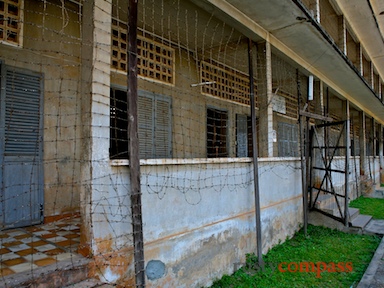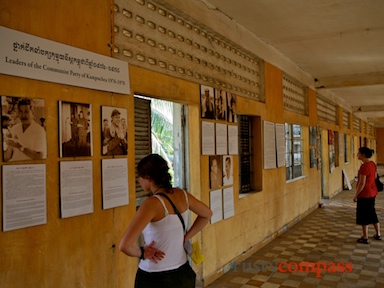In August 1975, three months after the Khmer Rouge takeover of Cambodia, this school was transformed into the Khmer Rouge prison known as Tuol Sleng. More than three decades later in July 2010 its former commander Comrade Duch, was found guilty of crimes against humanity in a trial held just a few kilometres away.

Photo: Mark BowyerTuol Sleng Museum
The most notorious symbol of Khmer Rouge brutality is now a museum that at once engages and repels. Cambodia is still on a long road of recovery from the horrors of the Khmer Rouge. A visit to Tuol Sleng provides some powerful insights not just into the Khmer Rouge brutality, but into the people who were the Khmer Rouge.
While a few years ago, only a small number of the rooms in the school complex were open, on my most recent visit, many more had been opened, presumably to accommodate the growing number of tourist visits.
I previously described Tuol Sleng as "one of the most powerful museum experiences in Asia - founded in part on its subject matter and in part in the understated efforts to give life to all of the strands in the Khmer Rouge story." After my most recent visit, I felt more ambivalent.
The expansion of the exhibition - with more torture rooms opened and more images over many floors - seems to have been at the expense of the museum's effort to illuminate visitors about the past.
Though this has been corrected somewhat with the addition of an informative audio tour in 2015.
The museum's ground floors have two sections. There are the former torture chambers, said to have been left largely unchanged since the arrival of Vietnamese troops in 1979 who liberated the prison. Many more of these have been opened in recent years. There are also many rooms of galleries, room after room, of images of the faces of victims of the Khmer Rouge genocide.
Upstairs, a more recent addition to the museum contains a simple exhibit that provides some background on who the Khmer Rouge were, the mix of historical forces that fueled their growth and most profoundly, the simple men, now mostly returned to their villages tending farms and grandchildren, who were the foot soldiers of the Khmer Rouge.

Photo: Mark BowyerHistorical section at Tuol Sleng
The museum seems to overlook the role of the massive US bombing of Cambodia in swelling the ranks of the fledgling Khmer Rouge in the early 70s. Historians have long argued about the precise impact of the Nixon / Kissinger bombing campaign. Comrade Duch in his testimony spoke of the invaluable fillip the bombing gave to Khmer Rouge recruitment.
17,000 prisoners were detained here during the four years of the Khmer Rouge reign. Most died either here from torture or at the Killing Fields of Cheung Ek 17 kilometres away.
Many travellers choose to also visit the Killing Fields. For others, Tuol Sleng is enough. Certainly Tuol Sleng needs to be seen.
To read of the ghosts of Tuol Sleng and for a sense of the seemingly interminable delays in bringing Khmer Rouge leaders to justice, see Seth Mydans’ 1999 piece from the New York Times here.



















There are no comments yet.